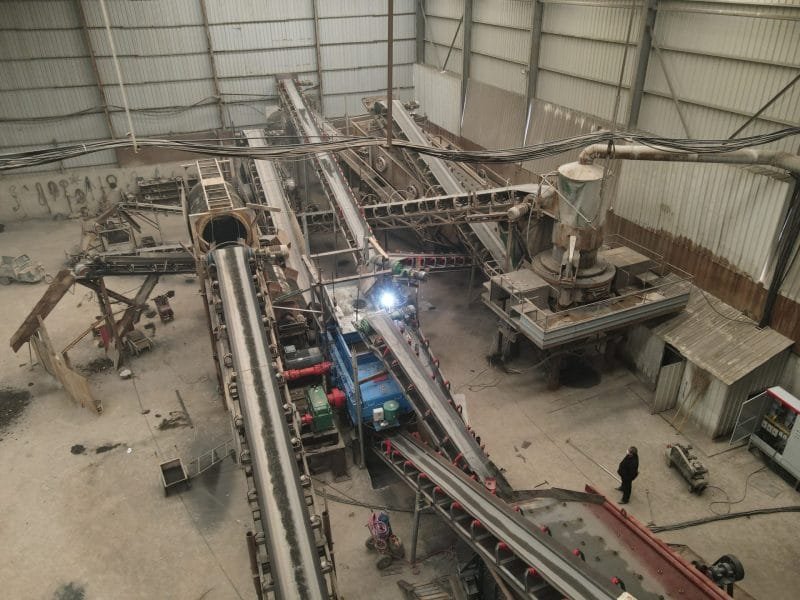With the depletion of natural sand resources and increasingly strict environmental protection policies, artificial sand has become the main source of aggregate in the construction industry. Among various sand making equipment, double roll crusher has attracted much attention due to its unique crushing principle and flexible control ability. Through the latest industry data and engineering cases, we understand the application prospect of double-roll crusher in construction sand production from three dimensions of technical adaptability, product quality and economic benefits.

Construction Sand Roller Crusher
I. Technical Adaptability Analysis
1. Raw Material Processing Capacity
Double-roll crushers can effectively process rocks with compressive strength ≤160 MPa (e.g., granite, limestone, basalt) and recycled construction waste aggregates. Their “compression + shearing” crushing mechanism is particularly suitable for medium- to low-hardness materials. Compared to impact crushers, they reduce tool wear rates by over 40% when processing high-silica-content rocks (e.g., quartzite).
2. Particle Size Control
By adjusting the gap between rollers (1-20 mm adjustable) and roller surface patterns, output particle size can be precisely controlled:
Coarse sand production (fineness modulus 3.1-3.7): Deep-grooved roller surfaces with 8-15 mm gaps
Medium sand production (fineness modulus 2.3-3.0): Shallow-toothed roller surfaces with 3-8 mm gaps
Fine sand shaping: Achieved through air classification systems for 0.15-0.6 mm particles
Experimental data show that the gradation curve of sand produced by double-roll crushers matches 92% of the GB/T 14684-2022 standard Zone II sand requirements, significantly outperforming hammer crushers (75%) and cone crushers (68%).
II. Product Quality Verification
1. Particle Shape Advantages
| Indicator | Double-Roll Crusher | Impact Crusher | Vertical Shaft Crusher | National Standard |
|---|---|---|---|---|
| Flakiness index | ≤8% | 15% | 12% | ≤10% |
| Crushing value | 14%-18% | 20% | 22% | ≤25% |
| Clay content | ≤0.5% | 1.2% | 0.8% | ≤3.0% |
(Data source: Comparative Study on Manufactured Sand Performance by China Building Materials Academy)
Sand particles produced by double-roll crushers exhibit polyhedral shapes with moderate surface roughness, enhancing cement paste bonding strength by 15%-20%, making them ideal for C30-C60 concrete.
2. Stone Powder Control
Integrated intelligent air classification systems stabilize stone powder content at 7%-12%:
- Low-grade concrete: Retain 10%-12% stone powder to partially replace cement
- High-strength concrete: Reduce stone powder to <7% via secondary separation
This technology lowers concrete costs by 8-15 CNY/m³. At a commercial concrete plant in Shandong, annual savings exceeded 3 million CNY.
III. Economic Efficiency Comparison
A comparative analysis of ROI for three mainstream equipment types in a 100 t/h sand production line:
| Item | Double-Roll Crusher | Impact Crusher | Vertical Shaft Crusher |
|---|---|---|---|
| Equipment cost | 850,000 CNY | 1.2 million CNY | 1.5 million CNY |
| Power consumption/t | 1.6 kWh | 2.8 kWh | 2.2 kWh |
| Wear parts cost/year | 60,000 CNY | 180,000 CNY | 120,000 CNY |
| Total cost/t sand | 9.2 CNY | 14.5 CNY | 12.8 CNY |
(Note: Calculated at 0.75 CNY/kWh, annual operation of 300 days)
Double-roll crushers achieve a payback period of 14 months, 6 months shorter than impact crushers. At a Yunnan sand plant, equipment utilization reached 91%, with downtime reduced by 65%.
IV. Typical Application Scenarios
Case 1: Ultra-Fine Sand Modification in Yangtze River Basin
A Hubei project optimized locally sourced ultra-fine sand (fineness modulus 1.8) using a 2PGC1200×1000 double-roll crusher:
Reprocessed 3-5 mm coarse aggregates into 1-3 mm particles
Improved sand fineness modulus to 2.4
Increased 28-day concrete strength from 32.5 MPa to 38.7 MPa
This project resolved the Yangtze River sand’s “over-fineness” issue, winning the 2023 China Sand & Stone Industry Innovation Award.
Case 2: Construction Waste Recycling in Zhengzhou
A waste treatment center adopted double-roll crushers to produce recycled sand:
Crushed demolition concrete to 0-4.75 mm
Removed impurities via magnetic + air classification
Replacement rates: 100% for masonry mortar, 40% for C30 concrete
Annual processing: 500,000 tons of construction waste, saving 350,000 m³ of natural sand, with carbon reduction equivalent to planting 340 hectares of forest.
V. Technical Limitations and Solutions
1. High-Hardness Material Processing
Challenge: Roller surface wear rate reaches 0.8 mm/10,000 tons for basalt.
Innovations:
Tungsten carbide roller sleeves (lifespan: 50,000 tons/pair)
Hydraulic quick-change systems (replacement time: 2 hours vs. 8 hours)
2. Moisture-Induced Clogging
Challenge: Material adhesion when moisture content >5%.
Solutions:
Ultrasonic roller cleaning systems
Hot-air drying systems for moisture control
Double-roll crushers not only produce construction sand meeting national standards but also excel in particle shape optimization and stone powder control. Driven by China’s “Dual Carbon” strategy, their low energy consumption and high resource efficiency make them a preferred solution for manufactured sand production. Enterprises should prioritize roller materials and intelligent control systems during equipment selection, while tailoring processes to raw material characteristics to maximize technological potential.



